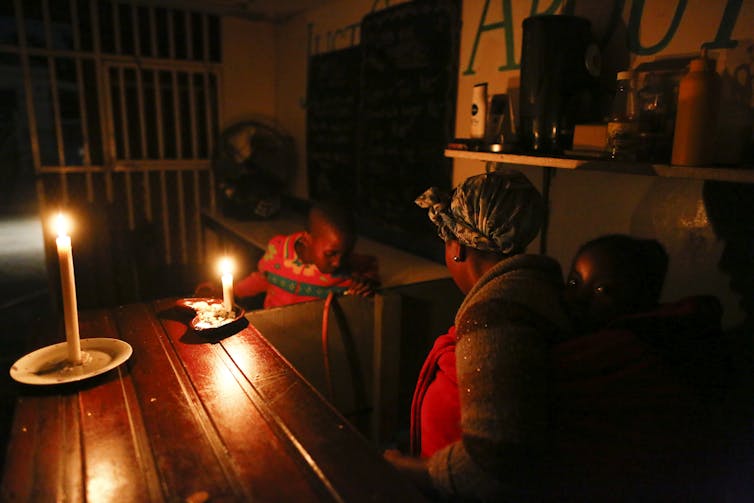
By Chris Gilmour
Once again, power utility Eskom has come to spoil the festive spirit for everyone with its rotational power cuts (referred to in Eskom-speak as load-shedding). This hasn’t been a feature, thankfully, for quite some time now and most of us would be forgiven for thinking that the appointment of a new board at the beginning of this year should have put an end to power cuts.
But no – as we are in the dark literally regarding the physical lack of power, we are also in the dark figuratively about what has caused this dire situation. If this carries on much longer, not only will many peoples’ festive seasons be ruined, but economic growth will undoubtedly begin to suffer as well.
But this time around there is a different feel to that during previous rotational power cuts. It’s as if this shouldn’t really be happening – and yet a cadre of individuals at the top of Eskom and within the ANC government appear to know precisely what is going on, but are not giving us the full story.
Eskom is in deep trouble, not just at an operational level but also regarding its financials. Not only can it no longer provide a reliable source of energy; it is extremely doubtful whether it remains a going concern. With R419 billion of debt, there is no way that it can trade its way out of the mess in which it finds itself, an observation endorsed by chairman Jabu Mabuza’s remarks at the recent results presentation in which he said the current situation was “not sustainable”.
Adding spice to the story is a report from the Mpumalanga Chamber of Commerce that states unequivocally that substantial coal stocks are piling up in that province, with Eskom showing no evidence of urgency in procuring this coal.
According to Eskom, the current situation is as a direct result of a lack of maintenance of its power plants, especially in the past couple of years, with ancillary factors being a loss of power from Cahora Bassa in Mozambique due to power lines being down, a shortage of diesel to operate the two open-cycle gas turbine (OCGT) plants in the western Cape and a lack of head of water to properly operate pumped storage systems properly.
The poor maintenance has resulted in a number of plant breakdowns (unplanned maintenance in Eskom-speak). To try to get a handle on just how bad this situation is, it is necessary to take a long, hard, look at Eskom’s total electrical generating capacity.
Currently the utility operates a fleet of 13 coal powered stations whose commissioning dates range from 1966 (Komati power station) to 1996 (Majuba power station). There are two other coal-fired stations being built, Medupi and Kusile, but both are years behind schedule and only a few units from each are currently supplying power to the national grid. Once Medupi and Kusile are both fully commissioned around 2022, the gap between new builds will have been 22 years.
There is a solitary nuclear plant at Koeberg in the western Cape, which produces approximately 1 800 Megawatts (Mw) of power. The thirteen coal-fired plants have a combined nameplate output of 37 530Mw. Thus, coal and nuclear combined can produce 39 330Mw of power. These stations produce what is referred to in the industry as “base-load” power. In other words, this is the basic power that is produced on a continuous basis, day and night, except when stations are switched off for essential maintenance.
In addition to these base-load stations, Eskom also derives power from a variety of other sources, including Open-Cycle Gas Turbines (OCGTs), hydro power, a variant of hydro power called pumped storage power, as well as buying power from the Cahora Bassa hydroelectric scheme in Mozambique. OCGTs, as the name suggests, were originally intended to run on natural gas, but have been modified to run on significantly more expensive diesel.
Eskom’s two OCGTs produce approximately 2 000Mw combined, while its four small hydroelectric plants – Palmiet, Gariep, Vanderkloof and Port Rex – have a combined capacity of approximately 1 000Mw. The two large pumped storage systems – Drakensberg and Ingula – do not produce additional electricity in their own right but are able to produce power at peak times
Eskom also has a power purchase agreement with an independent OCGT operator called Avon, which operates two diesel-powered plants called Avon and Dedisa – that collectively produce 1 000Mw of power when required.
And then there is renewable energy, comprising a number of solar and wind farms dotted around the country. These are mainly owned by the private sector and have been steadily producing power, in terms of the Renewable Energy Independent Power Procurement Programme (REIPP), for a number of years.
Opinions vary as to how much capacity is available from this source, but a figure of around 6 000Mw seems to be the consensus view. However, due to the intermittent nature of wind and solar power, only a percentage of this capacity can be relied upon at any given time. Industry experts usually agree on 25%, and thus the total available from renewables is probably no more than 1 500Mw.
To dimension just how bad the situation is, consider this: Eskom is able to produce around 45 000MW of electricity, if all plants are working at nameplate capacity and there are no breakdowns, planned or otherwise. It also has access to at least another 4 000MW in the form of electricity from Cahora Bassa and the combined output from independent suppliers, either in the form of renewable or non-renewable energy.
That is a total of around 49 000MW. In the first week of December, demand was running at around 29 000MW and from the 10th of December to the end of December, it is unlikely to exceed 25 000MW. Is it conceivable, therefore, that Eskom has outages totalling 24 000MW on any given day?
If so, the utility is plumbing new and uncharted depths in its breakdown patterns. And if that is indeed correct, it is exceptionally worrying and highlights the extent of Eskom’s operational problems.
Eskom hosted a media conference at its Megawatt Park HQ last week and Minster of State-Owned Enterprises Pravin Gordhan was in attendance. It appeared to be a full and frank discussion, and questions appeared not to be deflected to any great extent. Gordhan pointed out that the new build programme was disappointing – not only in terms of the time and cost over-runs, but also in terms of the generators at Medupi not meeting nameplate output.
We can draw some solace from the weekly status reports that Eskom supplies on its website. This shows that demand is forecast to plummet from the week beginning Monday 10 December, as industries wind down for the holiday period and families go on vacation. And yet, as this column is being written (Sunday 9 December) we have been subject to another Saturday of rotational power cuts. Something is seriously amiss.
There are those of a conspiratorial turn of mind who have suggested that Eskom is engineering this crisis with a view to turning public and government opinion in the direction of looking seriously at some type of privatisation.
It is rumoured that Eskom has already presented a turnaround plan to government that envisaged some sort of private sector involvement, splitting the utility up into its component parts of generation, transmission and distribution and widespread retrenchments. Understandably, government is believed to have been spooked by such a suggestion, just months away from a general election in May 2019.
It is not clear how Eskom can extricate itself from the mess in which it finds itself. The utility was hollowed out during the Zuma years, undoubtedly, but had been limping along long before that. When the utility was established in the early 1920s, its main aim was to provide cheap, reliable energy to the mines and industry.
Residential supply came much later and gradually replaced the host of municipal power stations that had been built up until the 1950s. To be sure, Eskom only catered for the white population from inception until the late 1980s/early 1990s. But with the dawn of democracy, it really came to the party in terms of electrifying the townships. Properly managed, Eskom could have been a genuine force for good in South Africa – but instead, it was hijacked for political purposes and has been badly mismanaged for over 20 years. There is now more than a 20-year gap in supply, due to Eskom prevaricating over its new build programme. The utility went from a huge over-supply situation to being in deficit in a remarkably short space of time and it has never really managed to catch up.
Thanks to successive substantial price increases over many years, Eskom’s global price-competitiveness has now totally evaporated. It has gone from being one of the cheapest global suppliers of electricity to being in the mid to upper band. And that situation will only get worse if the electricity regulator, NERSA, grants Eskom it 15% increases over the next three years.
Electricity demand has been falling in South Africa for a number of years now, due to a variety of reasons but predominantly because consumers are unable or unwilling to pay the expensive tariffs now demanded by Eskom.
There is a solution to Eskom’s situation, but it is one that is politically unpalatable. It is not too far removed form the plan that is rumoured to have been presented to government recently. First, Eskom must be split into its three component parts of generation, transmission and distribution.
Then the private sector must be invited to participate either in part or in whole. The private sector would leap at the chance of participating in distribution and transmission but there is unlikely to be an appetite for Eskom’s old and broken power plants. The various businesses will require to be streamlined with the attendant job cuts.
The consequences of maintaining the status quo are horrific. Eskom needs large chunks of institutional money, and fast. But with a rating deep in junk territory, it cannot in all conscience even consider taking on more debt. It has asked government for a R100m bailout, but unless extremely tight conditions are imposed, it will be yet another example of throwing good money after bad in another failed state-owned enterprise.
If it doesn’t get a bailout, it will limp along, attempting to patch up its creaking infrastructure and hoping that the highly-trained individuals at its operations nerve-centre at Simmerpan in Ekurhuleni continue to manage supply and demand.
If they don’t manage this delicate demand and supply balance, Eskom’s worst nightmare could result-a total breakdown of the entire system.
That would plunge the country into a situation from which it would be difficult and time-consuming to recover. Provided there is water in the two reservoirs at the Drakensberg and Ingula pumped storage systems, Eskom could use these two stations to attempt what is known in the industry as a “black start”. A black start is the equivalent of applying a defibrillator to the system, hoping that the grid can be gradually brought back up into service. Opinions vary as to how long the situation would persist, but most experts agree that it would take at least two weeks to get the power stations up and running again and synchronised to the grid.
This is a worst-case scenario and the odds of it occurring are extremely low. But in a dysfunctional utility like Eskom, with a continuing loss of institutional memory and operational ability, it remains a possibility.
Let’s just cross our fingers (or in South African parlance hold thumbs) that this cataclysmic situation never materialises.
Chris Gilmour is an Investment Analyst|Commentator|Writer
Like this article? Subscribe for free to ZA Confidential to receive our newsletters: Click here




